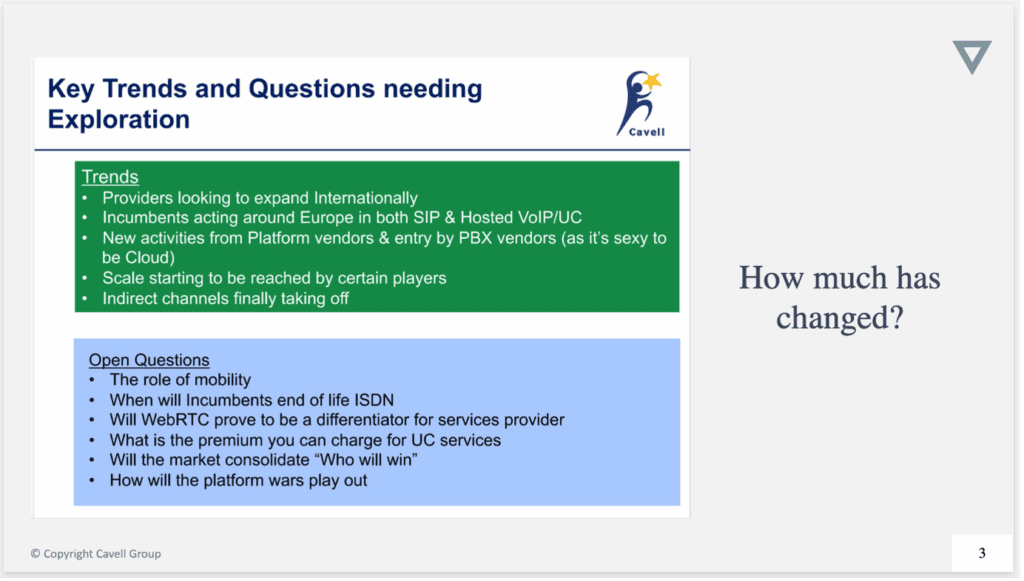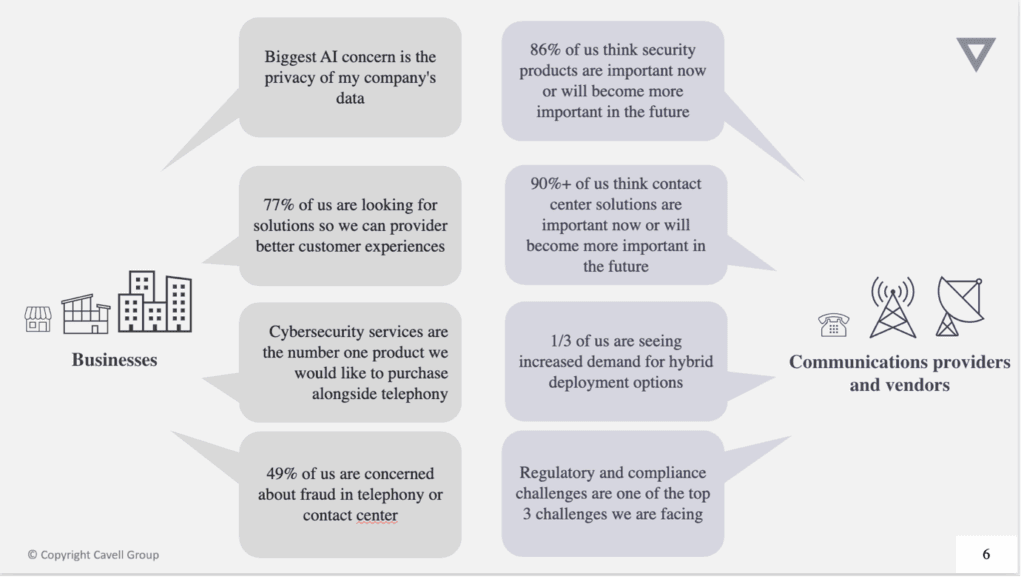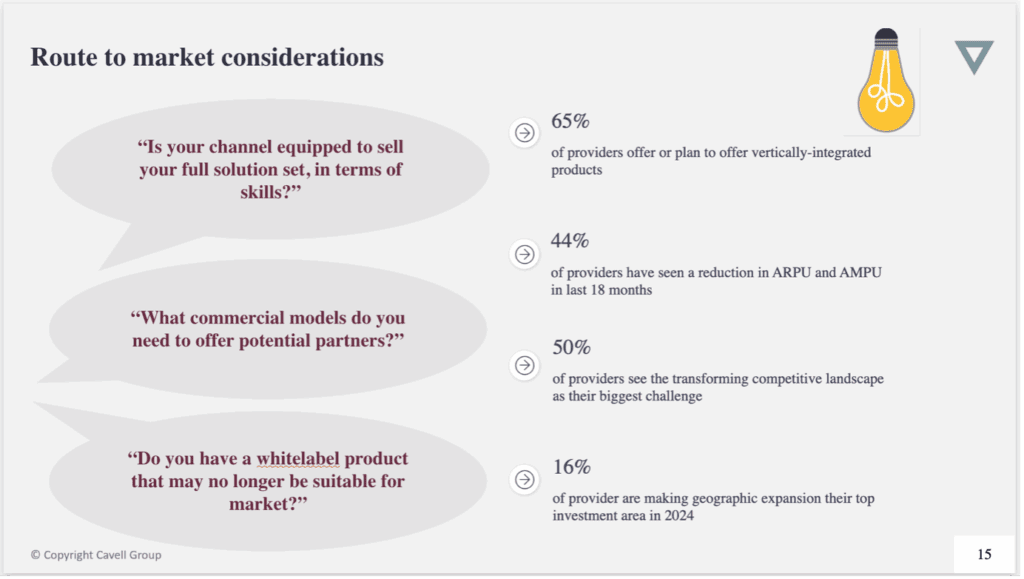Breaking Down Silos: Charting the Future of the Intelligent Workplace
At this year’s Cavell Summit EU, Managing Director Matt Townend delivered a compelling keynote that painted a picture of an industry in transition. Looking back at how far the communications sector has come and forward to where it’s headed, Townend offered attendees a roadmap for navigating the increasingly complex landscape.
“We’ve clearly been through a PBX-centric world, we went through a voice-centric cloud world, we’ve been in this collaboration era in the last few years,” Townend told the packed audience. “The question for all of us really is kind of where are we going next and where do the opportunities lie.”
The Intelligent Workplace: A New Vision for Communications
Central to Townend’s keynote was the concept of the “Intelligent Workplace”—an integrated approach to business communications that transcends traditional technology boundaries. This framework represents the natural evolution of communications technology, moving beyond siloed systems toward an interconnected fabric where data flows freely between platforms to improve communication experiences.
The Intelligent Workplace is fundamentally outcome-oriented rather than technology-centric. Instead of focusing on specific products or features in isolation, it emphasises how integrated technologies can address core business challenges. As Townend explained, at the centre of this approach are three main business objectives: to communicate effectively, to collaborate seamlessly, and to drive analysis for better business decisions.
Industry Evolution: From technology to Go-to-Market
Townend reflected on how industry discussions have evolved over the past decade. “It’s quite interesting what we were talking about ten years ago,” he noted, displaying slides from a previous event. “These were the trends in the market, and I thought some of them were quite amusing, really.”

The industry was still discussing technologies like WebRTC and “closing the PSDN in a number of markets.” Today, conversations have shifted dramatically from specific technologies to go-to-market strategies and how to drive value in an increasingly complex environment.
One constant throughout this period has been the importance of the indirect channel. “We were starting to say that the indirect channel was going to take off, and we’ve seen that drive a number of your businesses over the last ten years,” Townend remarked. “The indirect channel has been the lifeblood of this industry.”
Shifting Priorities: Security, CX and Hybrid Deployments
According to Townend, recent enterprise research reveals changing priorities across the market. While security and AI implementation remain critical concerns, customer experience (CX) has emerged as a dominant focus, with 77% of enterprises actively seeking better CX solutions. Simultaneously, organisations are expressing growing concerns about fraud and security vulnerabilities.

Perhaps most interestingly, after years of “cloud-first” rhetoric, the pendulum appears to be swinging back toward hybrid deployment models. Townend attributes this shift to geopolitical tensions and regulatory compliance requirements, noting that companies are becoming more strategic about where they host their data and applications.
“We are starting to see in AI and in cloud people talking a bit more about hybrid,” Townend observed. “Some people are concerned about the infrastructure and where they should host things and how we do that.”
The Integration Imperative: Breaking Down Silos
The most significant insight from Townend’s address was his analysis of how traditional technology silos are breaking down. Historically, communications technology has existed in separate product categories with minimal integration. Today’s business demands are rendering this approach obsolete.
“The way we kind of answered that traditionally is in quite a siloed approach to technology,” Townend explained, displaying a slide showing disconnected systems. “But it was quite siloed and we had point integrations and we had some data passing between these different things. As we move to these new demands, is that really going to cut the mustard for the customer?”
His answer was a resounding no. Townend envisions a future where core platforms—whether productivity suites, CRM systems, or communications tools—must function as part of an integrated ecosystem rather than standalone entities. The key to making this work, he emphasised, is data flow.
“When we talk about integration, we often forget that the main thing really here is about data,” he said. “How do we enable data to flow between these solutions? To bring intelligence, we have to have data flowing between those different capabilities.”
Changing Integration Priorities
This integration imperative is changing what businesses prioritise. Townend revealed that recent European research shows a significant shift in integration priorities. While CRM integration was once the clear leader, productivity suites now top the list, followed closely by vertical applications and analytics solutions.
“If I had put this up three years ago, it would have been CRM, it may have had Teams up there, and it had CRM, and then everything else would have been low down,” Townend noted. “But now the key applications I want to integrate in is my productivity suite, then my vertical applications, then my analytics solutions…because I want to provide better business decisions to my companies.”
The Rise of Vertical Solutions
The rise of vertical solutions emerged as another key theme. According to Townend, 65% of service providers now offer vertical-specific solutions, recognising that different industries have unique communications requirements that generic platforms cannot adequately address.

This evolution raises challenging questions for channel partners and service providers. “As we go to this kind of new world where we in some ways have got more complexity and we’ve got to simplify that, have we got the channels who can really help us there?” Townend asked. “Do we have to change the relationships to serve that broader requirement of the customer?”
The Skills Challenge and Automation
The skills gap was identified as perhaps the most pressing concern. “My biggest investment question in my mind right now is who provides the skills in this new world and how do we monetise that,” Townend admitted. As solutions become more sophisticated and integrated, traditional service delivery models are being stretched to their limits.
Automation will inevitably play a role in addressing these challenges. “There’s definitely a big drive for automation to bring out some of that value,” Townend noted, suggesting that technological solutions will help bridge some of these skills gaps.
vCon: The Future of Virtual Conversations
Among the emerging technologies, Townend highlighted vCon (Virtual Conversations) as being particularly interesting.
This emerging ITF standard represents a significant step forward in how communication data is handled. vCon allows data to be collected from multiple applications in a common format, enabling organisations to centralize conversation data for deeper analysis and benchmarking.
“vCon is the idea of virtual conversations. The ITF have now given a standard where we can take data in a common way from multiple applications and dump it into a large database and then start to drive insights and maybe benchmarking and things against that,” Townend explained.
He acknowledged that data protection regulations have been a significant hurdle: “The big challenge there has been GDPR and things like that.” However, he pointed to progress in this area, mentioning companies like “Space and Time who do all the crypto authentication” and “Creo solutions” who are developing compliant approaches to handle this sensitive data.
Verticalisation and Industry-Specific Solutions
The rise of vertical solutions emerged as another key theme in Townend’s address. According to his research, 65% of service providers now offer vertical-specific solutions, recognising that different industries have unique communications requirements that generic platforms cannot adequately address.
“If I’m really going to bring an intelligent workplace to my customer, then do I have to understand the context of their vertical well enough to do that? Do I have to really understand that business in enough detail to be able to provide that solution?” Townend asked the audience.
He mentioned the critical communications sector as one example, noting that solutions for “blue light” emergency services have specific requirements that differ substantially from generic business communications.
This verticalisation trend raises important questions for channel partners and service providers about specialisation versus generalization. “As we go to this kind of new world where we in some ways have got more complexity and we’ve got to simplify that, have we got the channels who can really help us there?” Townend asked.
Security Services Evolution and International Expansion
Townend drew an important distinction between traditional security approaches and newer opportunities in the security space. “When we’re talking about security, we’re not talking about [traditional firewalls],” he clarified, referencing his own past experience with Nokia checkpoint firewalls.
“We’re thinking now in a new way about how can you bring security services on top of what you do,” he continued, noting that businesses have “an appetite to receive services from you in this space.” The exact nature of these services wasn’t fully defined, but Townend indicated that Cavell would be revealing more on this front in the coming months.
The technological transitions underway have also created opportunities for service providers to expand beyond their home markets. Unlike hardware-centric solutions, cloud-based services can theoretically be delivered anywhere.
“Is a big question and a question that I believe a lot of UK businesses here haven’t really addressed,” Townend observed regarding international expansion. “Some have, but a lot of people have just decided to stay in their lane, stay in their market, and I think now the opportunity is certainly to broaden out of that.”
The Simplification Challenge
Townend closed by acknowledging the paradox facing the industry: as technology environments grow more complex, customers expect increasingly simpler experiences. “How do we take what appears to be quite a complex challenge and simplify it?” he asked.
For the assembled service providers and technology companies, the message was clear: the future belongs to those who can break down silos, enable data flow, understand vertical requirements, and deliver the expertise needed in an increasingly integrated communications landscape.
